To create a successful software product, businesses need more than talented engineers and project managers. The framework the team will follow to develop the product is essential as a means of defining the how and when of the process. Given the number of foundations to choose from, it can be a challenge for a team to decide which one best matches their context and needs.
This article will explore the popular software engineering methodologies to explain their advantages and disadvantages for different development projects. Competent software engineers and other tech professionals understand these approaches and how and when to apply them to achieve optimal results. Even if most don't seem appropriate for a particular project, they may become relevant in the future.
Benefits of a software development methodology
A software development methodology involves specific approaches, principles, and tools that refer to the framework teams use to structure, plan, and control the process of developing a software product. It defines how the team plans a project, assesses timeframes, and assigns priorities to the aspects of a product. Some frameworks allow for continuous adjustment to plans and deadlines based on input from stakeholders, while others require strict adherence to the original plan with little deviation.
Methodologies provide teams with a plan they can follow to create a valuable product. They also enhance the efficiency, quality, and predictability of software projects.
- Improved planning and organization: A structured approach ensures clear timelines, deliverables, and resource allocation to reduce the risk of delays and cost overruns.
- Enhanced communication and collaboration: Some methodologies promote consistent interaction among team members and stakeholders to foster better understanding and alignment.
- Higher quality and reliability: Defined processes for testing, validation, and iteration help create software that meets requirements and performs reliably.
- Risk management: Early identification and mitigation of risks are facilitated through milestones, reviews, and iterative development practices.
- Scalability and flexibility: Methodologies allow teams to adapt to changes in requirements, user needs, or market conditions without jeopardizing overall project goals.
There are clear advantages to adopting a methodology for a project; however, leaders face challenges in implementing these approaches due to various factors. If a team has never used any structure framework before, then managers can invest time to explain the purpose and benefits of applying it. Likewise, switching frameworks can create friction between leaders and employees. Understanding these challenges is the first step to identifying solutions.
- Resistance to change: Teams must adjust their workflow, learn new practices, and create different documentation, all of which can disrupt and increase their current workload.
- Initial learning curve: Understanding and effectively applying a methodology requires time, training, and practice, which can temporarily impact productivity.
- Misalignment with organizational culture: A methodology may clash with existing practices or values, such as a hierarchical culture struggling to adopt a collaborative approach.
- Inadequate tool or resource support: Effective implementation often requires specific tools, skilled personnel, or additional resources that may not be readily available.
These challenges are associated with changes to any software development methodology, and specific frameworks may present unique difficulties. As this article will show, not every methodology is appropriate for every software project or business. Teams need to understand the requirements of a framework, including any changes to a company's culture and resource allocation, to decide if it best fits their context. At times, an approach may require a cultural shift and other adjustments that involve resources a business has available. In this case, other approaches may be more appropriate.
Agile development
This is the most popular, or at the very least most discussed, methodology in software development. Since its creation, Agile has become an umbrella for a variety of other frameworks, such as TDD and BDD, some of which this article will explore separately.
Agile emphasizes adaptability, collaboration, and delivering small, functional increments of work in a short amount of time. It focuses on iterative development, where requirements and solutions evolve through collaboration between cross-functional teams. Agile values customer satisfaction and favors responses to change over a rigid plan. The framework also prioritizes working software over comprehensive documentation. The Agile Manifesto underpins its principles, advocating for frequent delivery of value and close interaction with stakeholders.
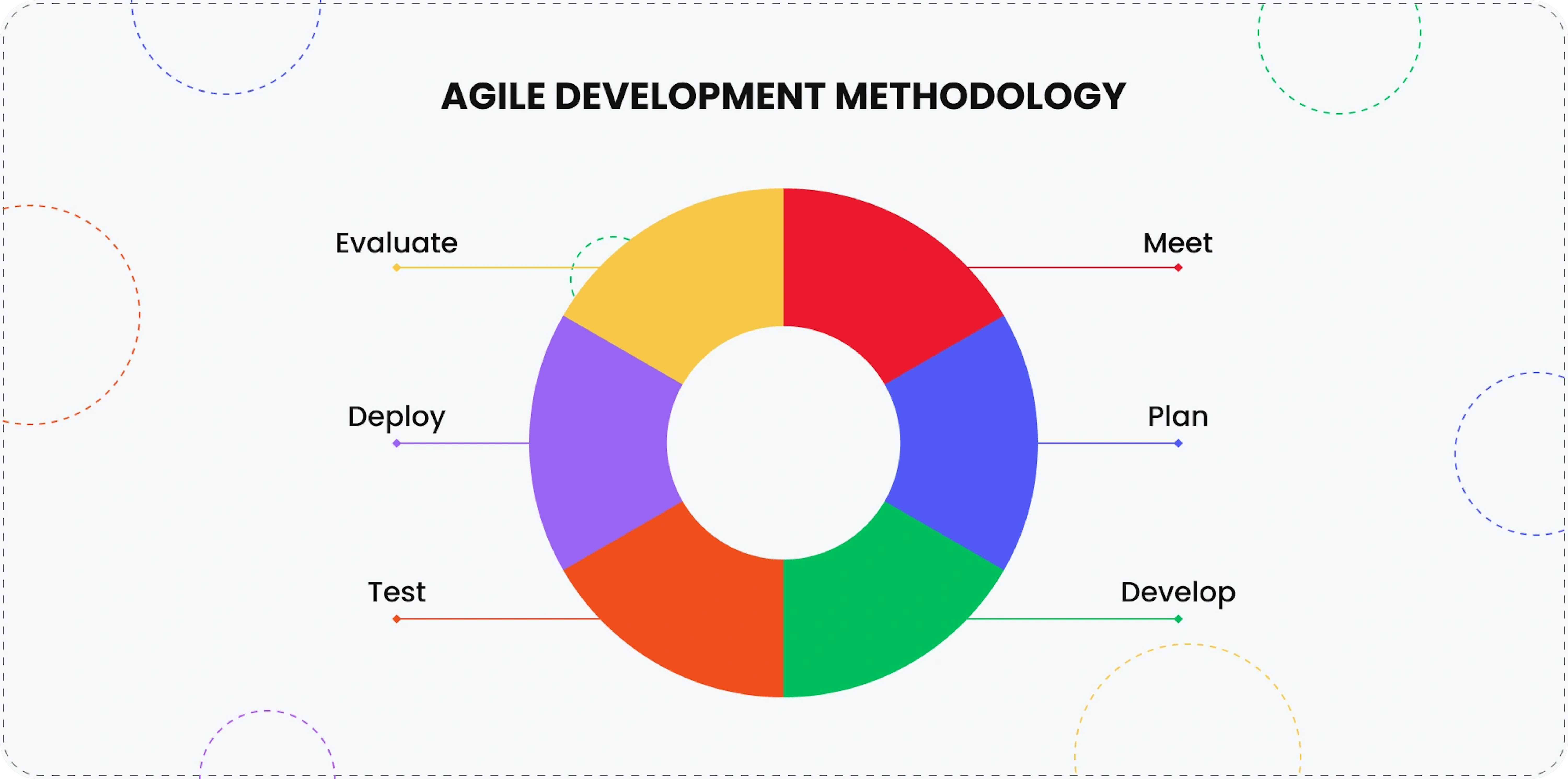
Agile projects typically begin with a vision and a backlog of prioritized tasks. Development occurs in iterations or sprints. The team produces a potentially shippable product increment in each sprint. Teams hold planning meetings at the start of each sprint, regular stand-ups for progress updates, and retrospectives at the end to reflect and improve. Stakeholders are involved throughout, providing feedback to refine the product and reprioritize the backlog as needed. This repeats until the project is complete or goals are met.
Advantages and disadvantages
There are plenty of reasons for Agile's popularity, given the advantages this methodology offers:
- Encourages adaptability to changing requirements and priorities.
- Promotes collaboration and regular communication with stakeholders.
- Delivers value gradually to enable faster feedback and adjustments.
- Supports team empowerment and continuous improvement through retrospectives.
- Reduces risk by addressing issues early in the development process.
Despite its popularity, there are challenges to implementing Agile:
- Requires significant stakeholder involvement and regular feedback.
- Can lead to scope creep without clear boundaries.
- May lack structure for teams unfamiliar with Agile principles.
- Less suitable for projects with fixed requirements and tight budgets.
- Relies heavily on team collaboration and self-organization.
Agile is ideal for projects with evolving requirements and high uncertainty, where flexibility and customer feedback are essential. It works best for teams that appreciate collaborative, iterative environments and can work without a firm structure. Agile is well-suited for industries like software development and digital marketing, where adaptability and speed are critical. Teams looking to foster innovation and improve time-to-market benefit significantly from Agile. Agile is also a good starting point for organizations that want to transition to an iterative, customer-focused approach.
The Waterfall model
Waterfall is a traditional, linear software development methodology where each phase of the project flows sequentially into the next. While Agile may have replaced it in terms of popularity, the Waterfall model still serves as a suitable framework for certain situations. It follows a structured process, starting with requirements gathering, then design, implementation, testing, deployment, and maintenance. Waterfall emphasizes thorough planning and documentation at every stage, ensuring clear deliverables and milestones before proceeding. Requirements should be well-defined upfront and not encounter significant change. By maintaining a clear, step-by-step progression, Waterfall minimizes ambiguity and provides a straightforward framework for managing projects.
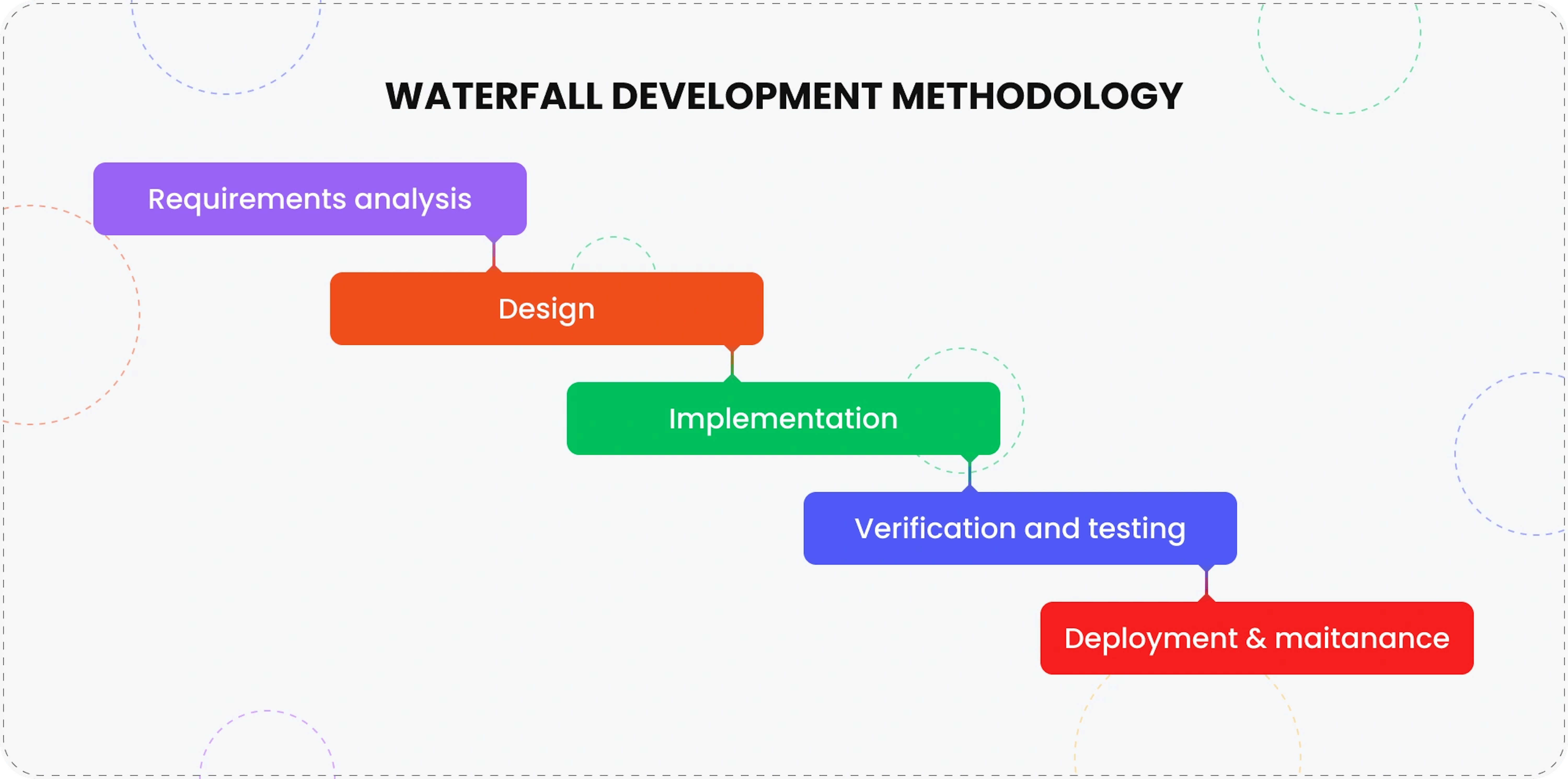
Teams that use Waterfall begin by gathering comprehensive requirements to define the project's scope and goals. The next phase involves designing the system architecture and technical specifications. Developers then implement the design, followed by rigorous testing to ensure quality and functionality. After successful testing, the product is deployed to users, with ongoing maintenance to address issues or updates. Each phase must be completed and reviewed before moving to the next, ensuring a controlled and predictable development process.
Advantages and disadvantages
As one of the first software development methodologies, the Waterfall Model offers certain advantages:
- Provides a clear and structured approach which is easy to understand and follow.
- Facilitates thorough documentation to provide long-term maintainability.
- Works well for projects with fixed requirements and little room for change.
- Offers clear milestones for straightforward progress tracking.
- Reduces uncertainty by addressing all requirements upfront.
The Agile approach grew from the disadvantages of the Waterfall model, which are:
- Rigid structure makes it difficult to adapt to changing requirements.
- Late discovery of issues can be costly and time-consuming to address.
- Requires complete understanding of requirements before development begins.
- Testing occurs late in the process, which increases the risk of defects reaching production.
- Less suitable for projects with high uncertainty or evolving needs.
Waterfall is ideal for projects with well-defined, stable requirements and minimal risk of changes, such as government contracts, construction projects, or hardware development. This approach is also suitable for startups that need the structure and guidance it provides to produce a product in a short amount of time. Waterfall works well for teams that prefer detailed planning and documentation to guide the process. Organizations with strict regulatory or compliance needs often choose Waterfall for its structured approach. This methodology suits projects in industries like manufacturing or engineering, where linear workflows and fixed deliverables are common. Projects with clear timelines and budgets also benefit from the predictability of Waterfall.
Kanban
Kanban is a visual workflow management methodology designed to improve efficiency, flexibility, and continuous delivery. With origins in lean manufacturing, it focuses on visualizing work, limiting work in progress (WIP), and optimizing flow to enhance productivity. The core principle of Kanban is to maintain a steady workflow by pulling tasks through stages only when capacity allows, reducing bottlenecks and inefficiencies. Work is represented on a Kanban board, typically divided into columns such as "To Do," "In Progress," and "Done" to provide transparency into the status of each task. Unlike methods like Scrum, Kanban has no fixed iterations; instead, work progresses as capacity allows without overwhelming workloads.
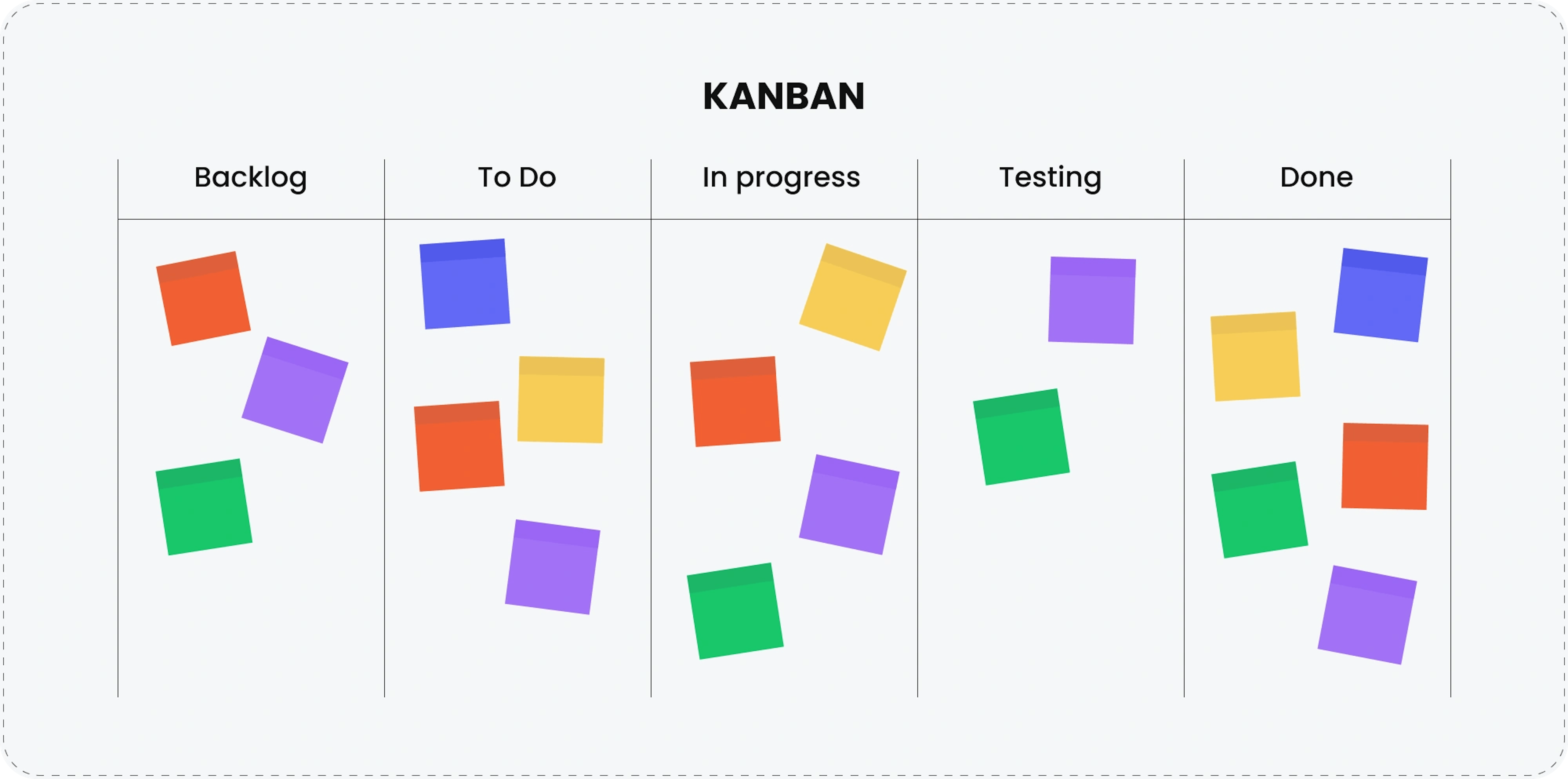
Kanban begins with visualizing the current workflow on a Kanban board and mapping tasks to different stages. Teams set WIP limits for each stage to prevent overloading and ensure smooth progress. Tasks are pulled from the backlog into the workflow based on priority and available capacity, progressing through defined stages. Continuous monitoring and adjustments help identify inefficiencies and refine processes. Regular reviews and feedback loops promote continuous improvement, allowing teams to optimize flow without disrupting ongoing work.
Advantages and disadvantages
Due to the benefits it offers, Kanban has been adopted by many businesses and teams:
- Enhances workflow transparency with a visual board.
- Reduces bottlenecks by enforcing WIP limits.
- Can provide continuous delivery without fixed iterations.
- Adapts easily to changing priorities and business needs.
- Encourages incremental process improvements for efficiency gains.
As with any approach, there are certain challenges and disadvantages that teams should consider:
- Requires discipline to maintain WIP limits and workflow consistency.
- Depending on the implementation, Kanban itself does not offer structured roles, which may lead to unclear responsibilities.
- Less prescriptive than Scrum and requires teams to define their own best practices.
Kanban works well for projects with continuous workstreams, such as IT operations, support teams, and maintenance projects. It can be applied to many other methodologies mentioned here as a way of organizing and visualizing workflows. Organizations seeking to optimize processes without major structural changes can benefit from Kanban's incremental improvement approach. It is particularly useful in environments where priorities frequently shift, as tasks can be reprioritized dynamically. Teams aiming to improve efficiency while maintaining a sustainable workload will find Kanban a valuable methodology.
Scrum
Scrum is one of several Agile frameworks designed to help teams deliver complex projects in increments through an interactive process. It emphasizes collaboration, flexibility, and continuous improvement to deliver functional increments of work in short timeframes, called sprints. A sprint typically lasts 1–4 weeks, during which a cross-functional team works on prioritized tasks from a backlog. Scrum involves ceremonies, such as sprint planning, daily stand-ups, sprint reviews, and retrospectives, which promote transparency and adaptation. The methodology relies on defined roles—Product Owner, Scrum Master, and Development Team—to maintain focus and accountability. By fostering frequent communication and feedback, Scrum encourages teams to adapt quickly to changes and improve over time.
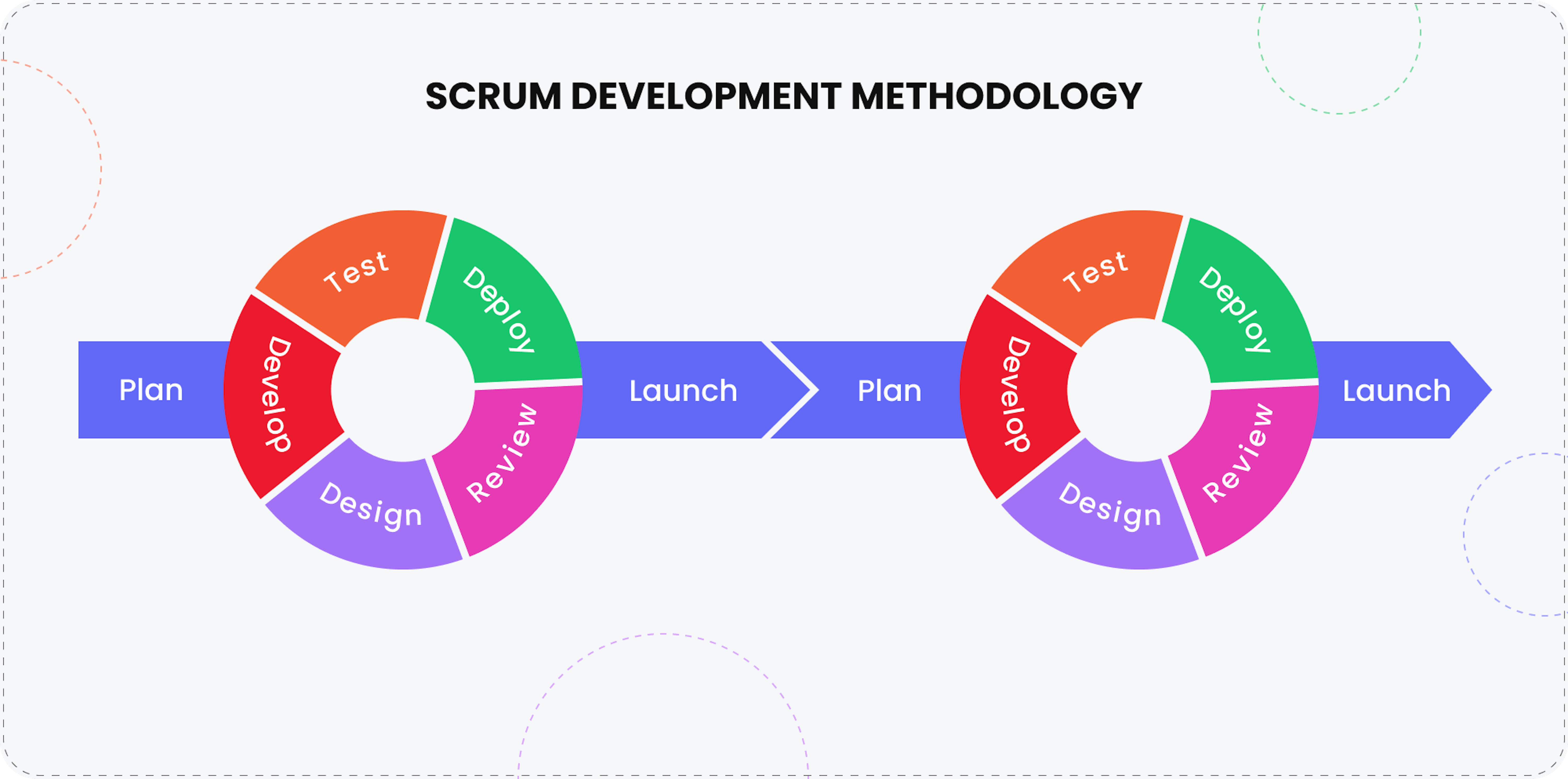
Scrum begins with a prioritized product backlog created by the Product Owner that details all tasks and features for the project. In sprint planning, the team selects items from the backlog to work on during the sprint. The team holds short, regular stand-up meetings to discuss progress, challenges, and goals. Then, the team conducts a review at the end of the sprint to demonstrate completed work to stakeholders, followed by a retrospective to discuss what went well and what could be improved. The cycle repeats with the backlog updated based on feedback and evolving project needs.
Advantages and disadvantages
The active nature of the Scrum approach offers several benefits:
- Promotes adaptability to changing requirements through short sprint cycles.
- Encourages frequent communication and alignment among team members.
- Provides early and continuous delivery of functional product increments.
- Facilitates stakeholder involvement and transparency.
- Focuses on improving team performance through regular retrospectives.
Teams that wish to adopt Scrum and implement it may face these challenges:
- Requires disciplined adherence to Scrum practices, which can be difficult for new teams.
- Relies heavily on a well-defined backlog, which can be time-consuming to maintain.
- Overemphasis on ceremonies may feel burdensome for small or less complex projects.
- Ineffective without strong commitment and collaboration from all team members.
- May not be ideal for projects with rigid timelines or fixed scopes that do not allow for flexibility based on feedback.
Scrum is ideal for projects with evolving or unclear requirements, where iterative feedback is essential. It suits teams that thrive on collaboration, communication, and adaptability. Besides software development, Scrum is equally effective in other industries where project goals can evolve. Teams with cross-functional expertise benefit the most, as this framework relies on collective ownership and self-organization. It's particularly effective for organizations seeking to embrace an Agile mindset and improve their ability to respond to change.
Rapid Application Development (RAD)
Rapid Application Development, or RAD, is a software development methodology designed for rapid prototyping and quick delivery of applications. It emphasizes minimal planning and extensive user involvement to enable teams to adapt quickly to changing requirements. RAD divides projects into smaller, manageable modules that different teams develop at the same time. Key principles include iterative development, frequent prototyping, and continuous feedback to ensure the product aligns with user expectations. RAD aims to reduce development time by relying on reusable components and automated tools. The framework relies on collaboration between developers and users to ensure the final product meets real-world needs effectively.
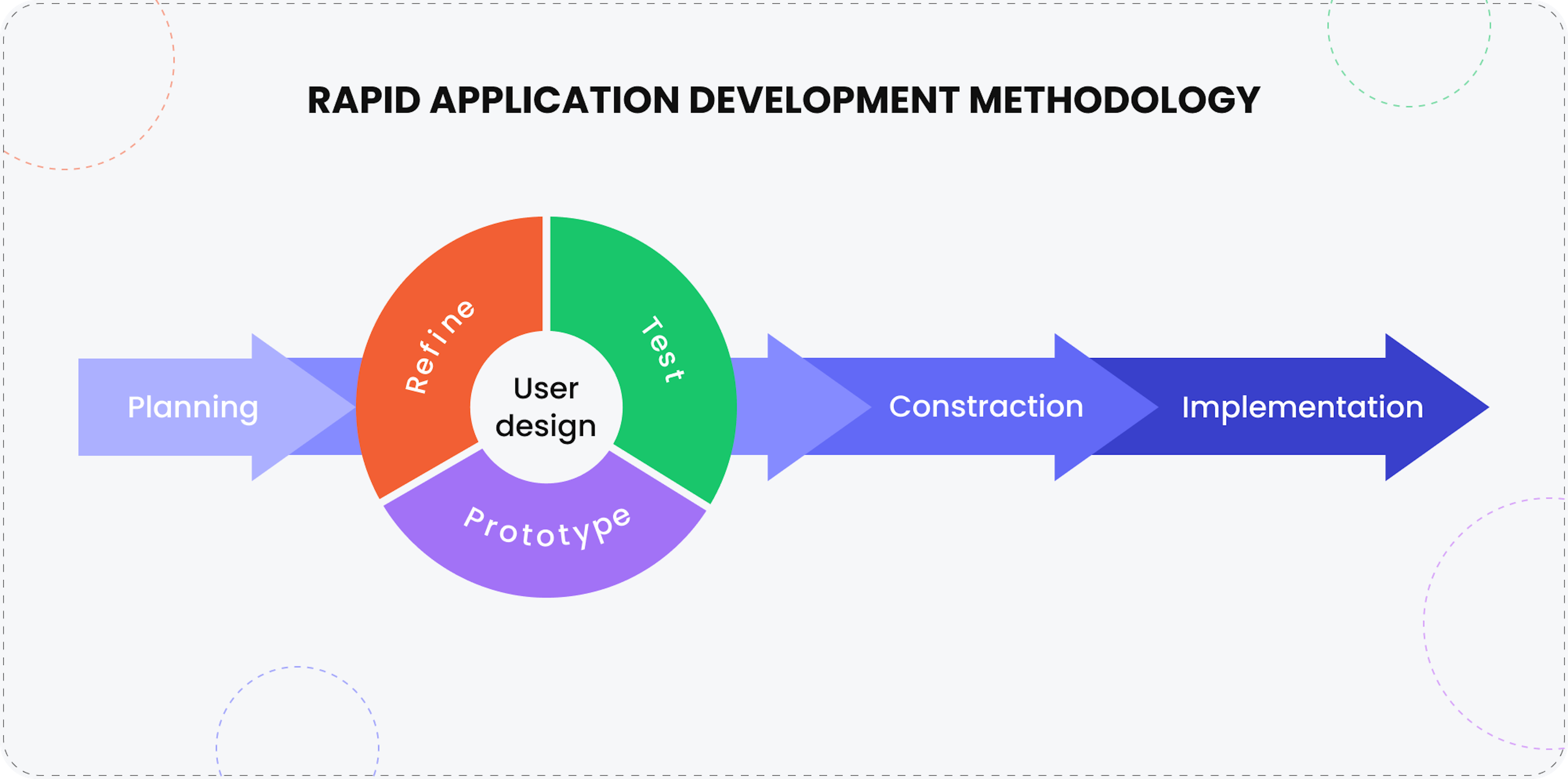
RAD begins with defining high-level requirements and creating a project scope. The team then rapidly develops prototypes to showcase functionality and gather user feedback. Developers refine these prototypes in iterative cycles, incorporate user suggestions, and address issues. Meanwhile, modules are built using reusable components and automated tools, which streamlines the development process. Once all modules are integrated and tested, the final product is deployed, with ongoing adjustments as needed.
Advantages and disadvantages
RAD is an appropriate model to use in certain situations given the following benefits:
- Reduces time-to-market with fast prototyping and iterative cycles.
- Encourages active user involvement to improve alignment with business needs.
- Facilitates the reuse of components to save time and resources.
- Provides flexibility to incorporate changes during the development process.
- Suitable for projects with tight deadlines and evolving requirements.
However, the particular characteristics of RAD create difficulties that teams may encounter if they adopt this approach:
- Requires constant user feedback, which may not always be feasible.
- Less suitable for projects with fixed requirements or large teams.
- Can result in poorly documented code if not managed carefully.
- Relies heavily on the availability of skilled developers and advanced tools.
- The lack of clear project boundaries may lead to scope creep.
RAD is ideal for projects with tight deadlines, evolving requirements, and a need for frequent user input, such as in web and mobile app development, where rapid delivery is crucial to market success. It works well for small to medium-sized teams that value speed and flexibility over rigid planning. Organizations seeking quick deployment of applications with iterative refinements can benefit from RAD. This methodology is useful in scenarios with available prototyping tools and reusable components.
Prototype Model
The Prototype Model is a development methodology that emphasizes creating a working prototype early in the project lifecycle to gather user feedback and refine requirements. This model is particularly useful for clarifying user needs and addressing uncertainties in complex projects. Through the iterative refinement of the prototype, the development team ensures that the final product aligns with user expectations and solves the intended problem. Key principles include user involvement, iterative development, and prioritizing core functionality over perfection in initial phases. There are two types of prototypes: throwaway (used for exploration) or evolutionary (built upon for the final product).
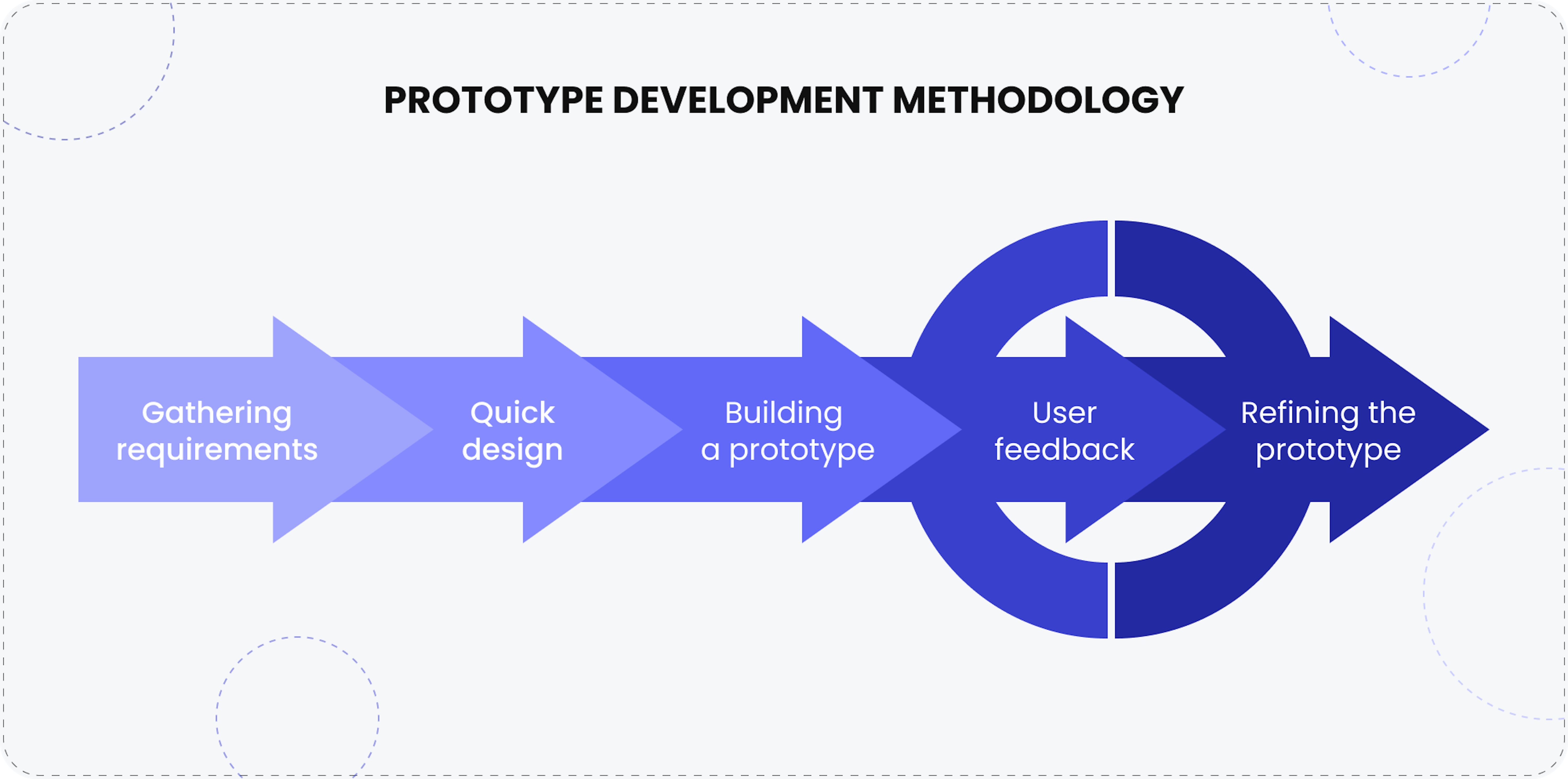
The process begins with gathering initial requirements and creating a basic prototype to demonstrate key functionalities. Users evaluate the prototype and provide feedback, which the development team uses to refine and improve it iteratively. This cycle continues until the prototype evolves into a final version that meets all requirements. Once finalized, the product undergoes thorough testing before deployment.
Advantages and disadvantages
The focus of this model on prototypes can deliver the following benefits:
- Helps clarify and refine requirements early in the project.
- Reduces misunderstandings between users and developers.
- Allows for early identification of design flaws and technical issues.
- Enhances user satisfaction by involving them in the development process.
- Supports flexibility to incorporate changes throughout development.
Unfortunately, there are several downsides that require consideration:
- Prototypes may lead to unrealistic expectations if users mistake them for the final product.
- Result creep is possible if requirements keep evolving.
- Requires skilled developers to build effective prototypes within expected timeframes.
- May increase costs and effort due to multiple iterations.
- Not suitable for projects with clearly defined, stable requirements.
The Prototype Model is ideal for projects with ambiguous or evolving requirements, where user input is crucial to success. It works well for systems requiring significant user interaction, such as user interfaces or custom software solutions. Organizations aiming to minimize risk by addressing potential issues early benefit from this model. It is particularly effective in research and development projects related to industries such as healthcare and education, where user feedback is critical.
Dynamic Systems Development Method (DSDM)
The Dynamic Systems Development Method, or DSDM, is an Agile framework focused on delivering business value through iterative development. It emphasizes collaboration, flexibility, and continuous improvement while adhering to a strict time and budget framework. Key principles include prioritizing work based on business needs (MoSCoW prioritization), active user involvement, and frequent delivery of functional increments. DSDM ensures that the project remains aligned with organizational goals by focusing on clear business objectives and stakeholder engagement. The methodology balances flexibility with control, making it suitable for complex, high-stakes projects.
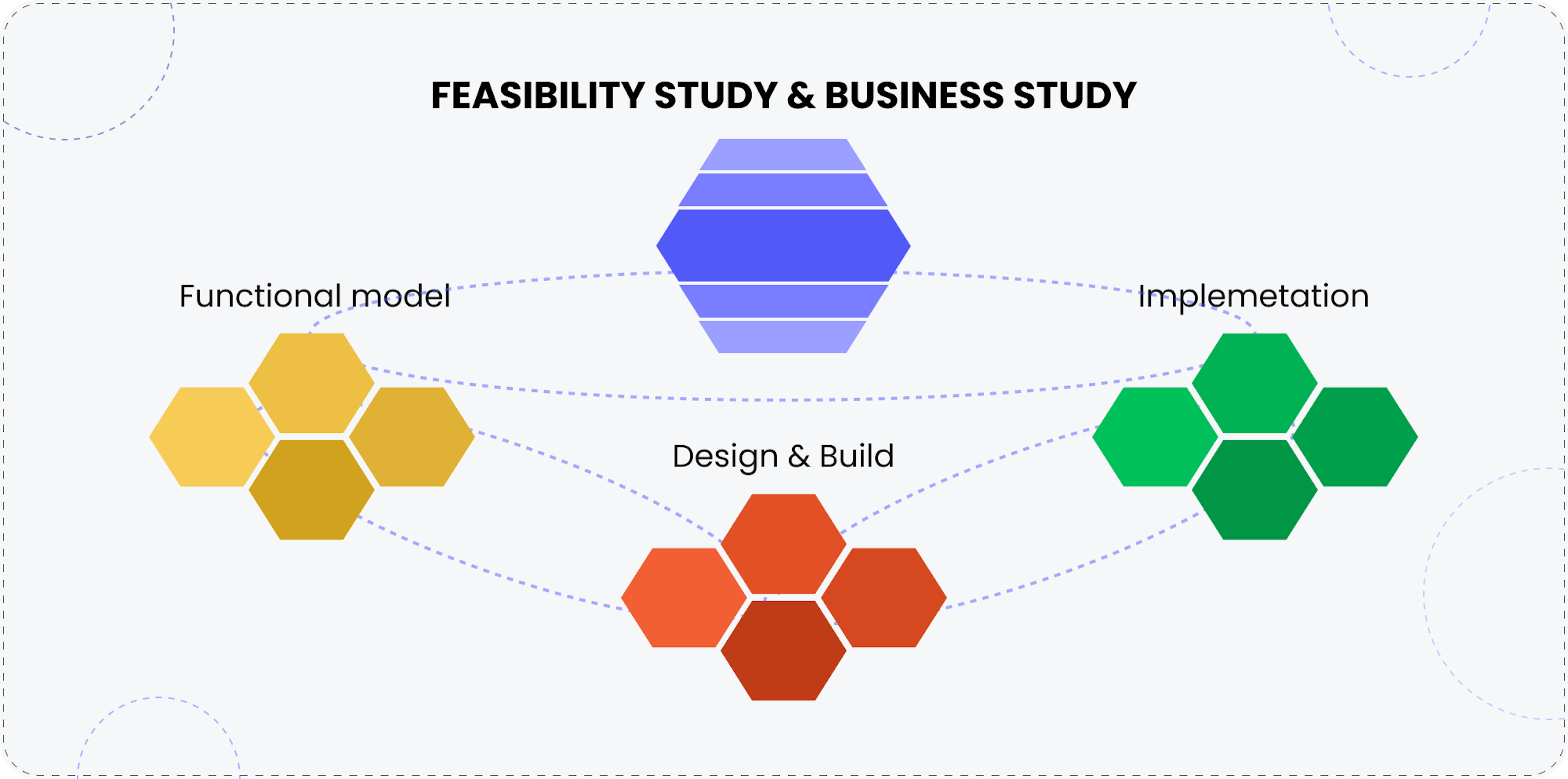
DSDM follows a structured lifecycle with phases: feasibility study, business study, functional model iteration, design and build iteration, and implementation. Each phase involves active user participation, iterative refinement, and prioritized task delivery. Regular reviews ensure alignment with business objectives, and changes are managed through iterative development.
Advantages and disadvantages
The DSDM methodology delivers several benefits to teams:
- Helps organize complex user feedback from multiple sources.
- Provides a structure to manage the many elements of high-stakes projects.
- Ensure flexibility while maintaining time and budget requirements.
- Reduces risk through iterative development and frequent delivery.
There are certain challenges teams need to understand before choosing this framework:
- Requires significant user and stakeholder involvement.
- May involve extensive planning and documentation compared to other Agile methods.
- Not ideal for small projects with limited scope.
- Relies on experienced teams to implement the framework effectively.
- Can be rigid for projects requiring extreme flexibility.
DSDM is ideal for complex, high-priority projects where business value must be delivered quickly and iteratively. It suits industries with strict regulatory requirements, such as finance or government. Teams that can commit to active collaboration with stakeholders and follow a structured Agile approach thrive with DSDM. It is particularly effective for organizations seeking a balance between Agile flexibility and project control. This methodology works well for enterprise-level projects with clear objectives and multiple stakeholders.
Feature Driven Development (FDD)
Feature Driven Development (FDD) is an Agile methodology that focuses on delivering tangible, working features in short iterations. It combines lightweight processes with a strong emphasis on design and quality, making it well-suited for large teams and complex projects. FDD's principles revolve around creating a feature list, iterative planning, and delivering features within well-defined timelines. Each feature represents a small, client-valued functionality that can be independently developed and tested. By focusing on features as the primary unit of progress, FDD ensures alignment with user needs and measurable outcomes.
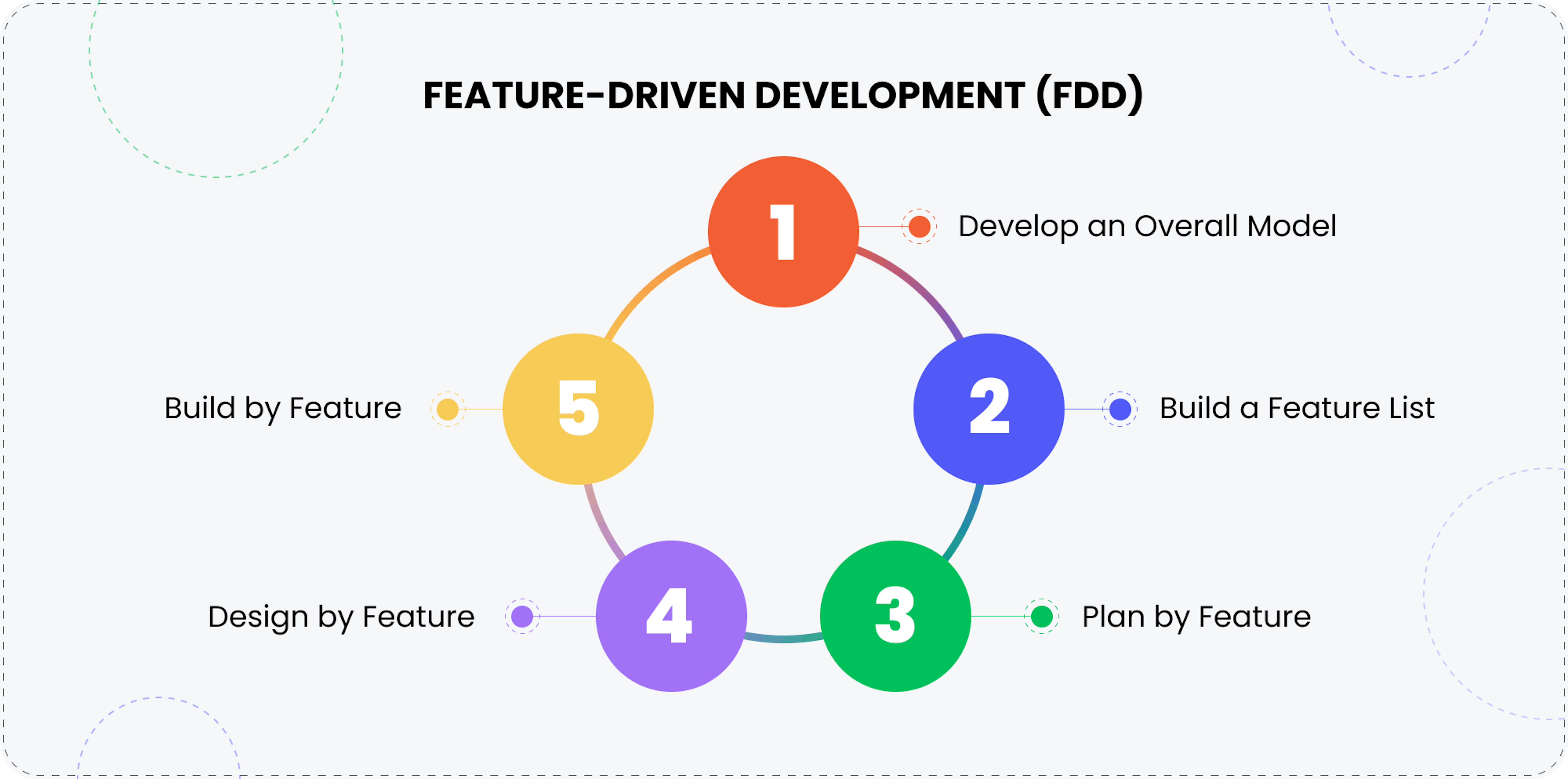
Teams that use FDD first create an overall model and a prioritized feature list. Developers plan by feature and group them into short iterations. Each iteration follows a structured process: design the feature, develop it, and test it for quality. They regularly check progress and communicate through feature completion milestones. The process continues until all features are completed and integrated into the final product.
Advantages and disadvantages
Teams that choose this approach will receive the following benefits:
- Delivers client-valued functionality in small, manageable phases.
- Feature complete metrics provide clear progress tracking.
- Emphasizes design and quality, reducing technical debt.
- Scales effectively for large teams and complex projects.
- Encourages collaboration and shared ownership within the team.
To reap the benefits above, teams need to also consider the disadvantages:
- Relies heavily on upfront planning and modeling, which can be time-consuming.
- Less flexibility for rapidly changing requirements compared to other Agile methods.
- May be overkill for small or straightforward projects.
- Needs consistent communication and coordination across large teams.
FDD is ideal for large-scale, complex projects where consistent quality and timely delivery are critical. It works well for teams with strong design expertise and clear feature-driven goals. Organizations with distributed teams or projects requiring detailed modeling and documentation benefit from FDD. This methodology is particularly effective for projects related to industries such as finance, telecommunications, or enterprise software, where scalability and feature reliability are paramount.
The software development process in action
Mad Devs relies on the principles of Agile software development with Kanban visualization. As a service company, the ability to change while focusing on a client's expectations is of great importance. Every team member is encouraged to feel responsibility for the product, and teams rely heavily on communication with the customer. Continuous integration and automatic delivery speed up the development cycle.
This extensive experience has allowed the professionals at Mad Devs to explain the benefits and challenges of these software development methodologies to representatives of different projects and businesses. In consultations and project management work, Mad Devs demonstrates a commitment to providing top-line assistance throughout the software development process.
Choosing the right software development approach
As noted in the description of each methodology, certain projects are better suited for one or another framework. Teams that are beginning a project will choose their approach based on the industry, their skillset, the client's requirements, and available resources. There is no single correct methodology; however, there are more appropriate and less appropriate options depending on these factors.
| METHODOLOGY | BEST FOR | PROCESS | BENEFITS | CHALLENGES |
|---|---|---|---|---|
| Agile | Projects with changing requirements and high uncertainty that require flexibility and customer | 1. Meet 2. Plan 3. Develop 4. Test 5. Deploy 6. Evaluate | ➕ Adaptability to changing requirements ➕ Promotes collaboration ➕ Supports team empowerment ➕ Reduces risk | ➖ Requires significant stakeholder involvement ➖ Can lead to scope creep |
| Waterfall | Projects with well-defined requirements and small risk of changes | 1. Requirement analysis 2. Design 3. Implementation 4. Verification and testing 5. Deployment and maintenance | ➕ Provides a clear and structured approach ➕ Facilitates thorough documentation ➕ Offers clear milestones | ➖ Difficult to adapt to changing requirements ➖ Requires complete understanding of requirements before development begins - Testing occurs late in the process |
| Kanban | Projects with continuous workstreams | 1. Visualization of current workflow on a board 2. Mapping tasks to different stages 3. Define limits for each stage 4. Move tasks through the workflow | ➕ Enhances transparency with a visual board ➕ Reduces bottlenecks by enforcing limits ➕ Easily adaptable to new priorities and needs | ➖ Requires commitment to maintain limits and consistency ➖ Lacks clear roles if used without other approach |
| Scrum | Projects with changing or unclear requirements that need iterative feedback | Agile process in sprints | ➕ Promotes adaptability ➕ Encourages frequent communication ➕ Early and continuous delivery of functional product phases | ➖ Requires disciplined adherence to Scrum practices ➖ Relies heavily on a well-defined backlog |
| RAD | Projects with tight deadlines, evolving requirements, and a need for frequent user input | 1. Planning 2. User design: - Prototype - Test - Refine 3. Construction 4. Implementation | ➕ Reduces time-to-market ➕ Facilitates the reuse of components ➕ Provides flexibility ➕ Suitable for projects with tight deadlines and evolving requirements | ➖ Can result in poorly documented code ➖ Relies heavily on the availability of skilled developers and advanced tools ➖ Lack of clear project boundaries |
| Prototype | Projects with ambiguous or changing requirements that rely on user input | 1. Gathering requirements 2. Quick design 3. Building a prototype 4. User feedback 5. Refining the prototype | ➕ Helps clarify and refine requirements ➕ Reduces misunderstandings ➕ Early identification of design flaws and technical issues ➕ Enhances user satisfaction | ➖ Prototypes may lead to unrealistic expectations ➖ Result creep is possible ➖ Requires skilled developers to build effective prototypes |
| DSDM | Complex and high-priority projects that demand business value be delivered quickly and iteratively | 1. Feasibility and business study 2. Implementation 3. Design and build 4. Functional model | ➕ Helps organize complex user feedback from multiple sources ➕ Provides a structure to manage high-stakes projects ➕ Reduces risk through iterative development and frequent delivery | ➖ May involve extensive planning and documentation ➖ Not ideal for small projects with limited scope ➖ Relies on experienced teams |
| FDD | Large-scale and complex projects that require consistent quality and timely delivery | 1. Develop an overall model 2. Build a feature list 3. Plan by feature 4. Design by feature 5. Build by feature | ➕ Delivers client-valued functionality ➕ Provides clear progress tracking ➕ Emphasizes design and quality | ➖ Relies heavily on upfront planning and modeling ➖ May be overkill for small or straightforward projects |
You can download this table in an image version, so you always have it at your fingertips:










